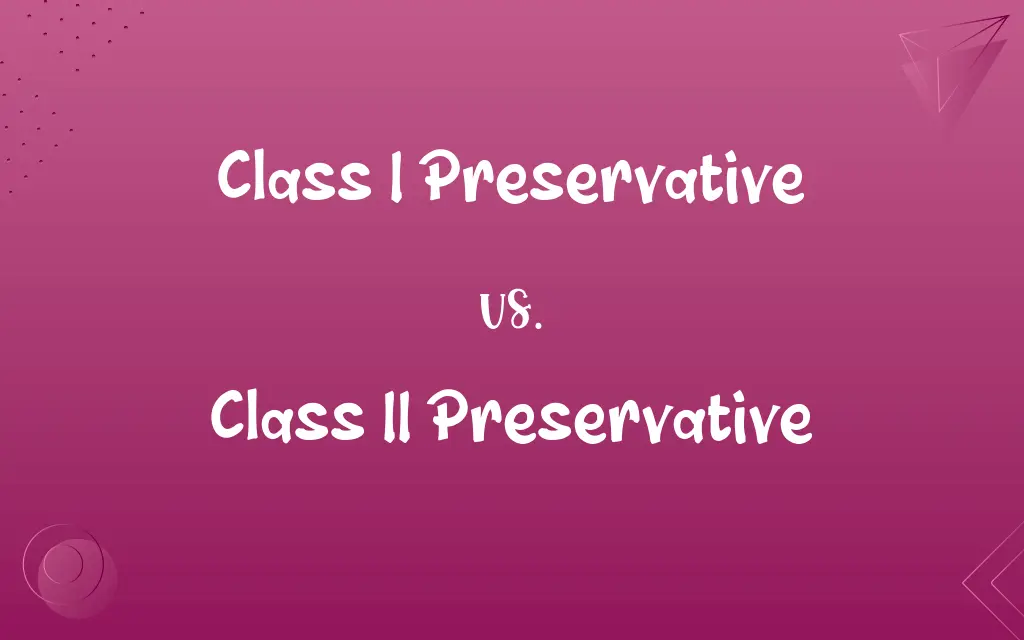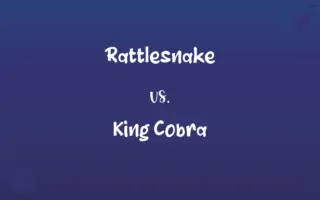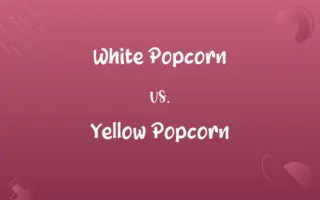Class I Preservative vs. Class II Preservative: Know the Difference

By Shumaila Saeed || Published on February 25, 2024
Class I Preservatives are naturally occurring substances like sugar and salt, while Class II Preservatives are synthetic, such as benzoates and sulfites.

Key Differences
Class I Preservatives are natural substances, often used in traditional food preservation methods. These include salt, sugar, vinegar, and certain natural acids. Class II Preservatives, on the other hand, are synthetic or man-made chemicals like benzoates, sulfites, and nitrates, developed to extend shelf life and maintain food quality.
Shumaila Saeed
Feb 25, 2024
Class I Preservatives work by altering the environment of the food, making it less hospitable to spoilage organisms. These include methods like dehydration, pH changes, or osmotic pressure alterations. Class II Preservatives often act as antimicrobials or antioxidants, directly inhibiting the growth of bacteria, molds, or yeasts, and preventing oxidation that leads to spoilage.
Shumaila Saeed
Feb 25, 2024
Class I Preservatives are generally considered safe due to their natural origin and have been used for centuries. However, Class II Preservatives, being synthetic, are subject to more rigorous regulatory controls and scrutiny regarding their potential health impacts, including allergies and other adverse reactions in some individuals.
Shumaila Saeed
Feb 25, 2024
Class I Preservatives are commonly used in products like jams, pickles, and dried meats. Class II Preservatives are frequently found in processed foods, canned goods, and beverages to enhance their stability and prevent spoilage.
Shumaila Saeed
Feb 25, 2024
There is a growing consumer preference for Class I Preservatives due to their natural origin and perceived health benefits. In contrast, Class II Preservatives are often viewed with more skepticism, leading to an increase in demand for 'preservative-free' or 'natural' food products.
Shumaila Saeed
Feb 25, 2024
ADVERTISEMENT
Comparison Chart
Safety and Regulation
Generally considered safe.
Subject to strict regulations.
Shumaila Saeed
Feb 25, 2024
Consumer Perception
Preferred for natural origin.
Viewed with more skepticism.
Shumaila Saeed
Feb 25, 2024
ADVERTISEMENT
Class I Preservative and Class II Preservative Definitions
Class I Preservative
Includes traditional preservation methods.
Vinegar, a Class I Preservative, is essential in pickling.
Shumaila Saeed
Jan 14, 2024
Class II Preservative
A synthetic chemical for food preservation.
Benzoates, as Class II Preservatives, are used in sodas.
Shumaila Saeed
Jan 14, 2024
Class I Preservative
A natural substance used to preserve food.
Salt, a Class I Preservative, is used in curing meats.
Shumaila Saeed
Jan 14, 2024
Class II Preservative
Can sometimes cause allergic reactions.
Some Class II Preservatives may trigger allergies in sensitive individuals.
Shumaila Saeed
Jan 14, 2024
Class I Preservative
Often used in artisanal and organic products.
Class I Preservatives are preferred in organic food processing.
Shumaila Saeed
Jan 14, 2024
ADVERTISEMENT
Class II Preservative
Common in processed and canned foods.
Class II Preservatives are found in many canned goods.
Shumaila Saeed
Jan 14, 2024
Class I Preservative
Preserves food by altering its environment.
Sugar, as a Class I Preservative, helps preserve jams.
Shumaila Saeed
Jan 14, 2024
Class II Preservative
Subject to more health and safety regulations.
Nitrites, used as Class II Preservatives, are strictly regulated.
Shumaila Saeed
Jan 14, 2024
Class I Preservative
Considered safer due to natural origins.
Natural acids used in food are Class I Preservatives.
Shumaila Saeed
Jan 14, 2024
Class II Preservative
Acts directly against spoilage organisms.
Sulfites, Class II Preservatives, prevent wine spoilage.
Shumaila Saeed
Jan 14, 2024
Repeatedly Asked Queries
Is salt a Class I Preservative?
Yes, salt is a common Class I Preservative.
Shumaila Saeed
Feb 25, 2024
Are Class I Preservatives safer than Class II?
Generally, yes, due to their natural origin.
Shumaila Saeed
Feb 25, 2024
What are Class I Preservatives?
Natural substances used for food preservation.
Shumaila Saeed
Feb 25, 2024
Do Class II Preservatives have side effects?
Some can cause allergies or other reactions in sensitive individuals.
Shumaila Saeed
Feb 25, 2024
Do Class I Preservatives alter the taste of food?
They can contribute to the food's flavor profile.
Shumaila Saeed
Feb 25, 2024
Why are Class II Preservatives used in processed foods?
For their effectiveness in extending shelf life.
Shumaila Saeed
Feb 25, 2024
Are Class II Preservatives bad for health?
They can be, especially if used excessively or in sensitive individuals.
Shumaila Saeed
Feb 25, 2024
What are Class II Preservatives?
Synthetic chemicals used to preserve food.
Shumaila Saeed
Feb 25, 2024
Can Class II Preservatives be natural?
No, by definition, they are synthetic.
Shumaila Saeed
Feb 25, 2024
Can Class I Preservatives prevent all food spoilage?
They are effective but may not prevent all spoilage.
Shumaila Saeed
Feb 25, 2024
Are Class II Preservatives more effective than Class I?
They can be more potent in preventing microbial growth.
Shumaila Saeed
Feb 25, 2024
How are Class I Preservatives regulated?
They are subject to food safety regulations but generally considered safe.
Shumaila Saeed
Feb 25, 2024
Can Class I Preservatives extend shelf life as Class II?
They can, but often less effectively than Class II.
Shumaila Saeed
Feb 25, 2024
Are there alternatives to using Class II Preservatives?
Yes, including natural preservation techniques and refrigeration.
Shumaila Saeed
Feb 25, 2024
Why is there a trend towards Class I Preservatives?
Due to consumer preference for natural ingredients.
Shumaila Saeed
Feb 25, 2024
What is a common Class II Preservative?
Benzoates are a widely used Class II Preservative.
Shumaila Saeed
Feb 25, 2024
Is sugar considered a Class I Preservative?
Yes, sugar is used as a natural preservative in many food products.
Shumaila Saeed
Feb 25, 2024
Is vinegar a Class I Preservative?
Yes, vinegar is widely used as a Class I Preservative.
Shumaila Saeed
Feb 25, 2024
Do Class II Preservatives affect food flavor?
They can, but are usually used in small amounts to minimize impact.
Shumaila Saeed
Feb 25, 2024
Can you find Class II Preservatives in organic food?
Organic standards typically prohibit or limit synthetic preservatives.
Shumaila Saeed
Feb 25, 2024
Share this page
Link for your blog / website
HTML
Link to share via messenger
About Author
Written by
Shumaila SaeedShumaila Saeed, an expert content creator with 6 years of experience, specializes in distilling complex topics into easily digestible comparisons, shining a light on the nuances that both inform and educate readers with clarity and accuracy.




































































